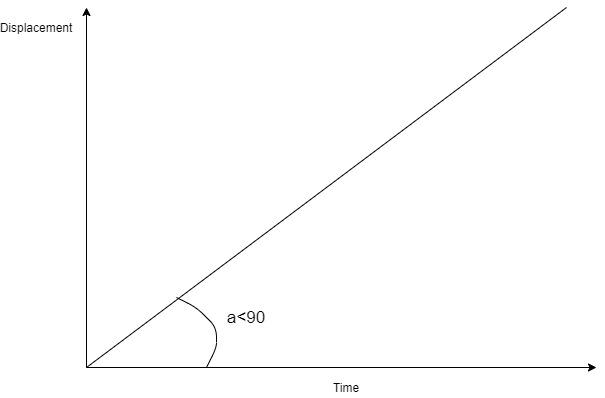
The displacement-time graph for a boy going to school with a uniform velocity will be :
A. Straight line incline towards the time axis with an acute angle.
B. Straight line incline towards the time axis with an obtuse angle.
C. Straight lines incline towards the time axis with a right angle.
D. Straight line parallel to time axis.
Answer
573.9k+ views
Hint:The displacement-time graph can be used to calculate the velocity by calculating the slope of the graph since –
Velocity, $V = \dfrac{d}{t}$
Complete step-by-step answer:
A body is said to be moving in uniform velocity if it covers equal distance in equal intervals of time.
For example, if a car covers 2 m in the first second, 4 m in 2 seconds, 6 m in 3 seconds, it is evident that the car is covering 2 m for every second.
Hence, the uniform velocity of the car is $2m{s^{ - 1}}$
The displacement-time graph for a motion with uniform velocity is :

The graph is a straight line and it is inclined at an acute angle with the time-axis.
Hence, the correct option is Option A.
Note: If the displacement-time graph is non-linear, we can calculate by the velocity using the following method.
Consider a displacement-time graph of a non-uniform motion as shown:

In such cases, we can calculate the instantaneous velocity i.e. velocity at the particular instant of time.
Here, the displacement is considered as a function of time.
$s = f\left( t \right)$
Differentiating the function with respect to time, will give us the velocity.
$V = \dfrac{{ds}}{{dt}}$
This is equal to the slope of the tangent drawn at any instant of time, as shown in the graph.
Velocity, $V = \dfrac{d}{t}$
Complete step-by-step answer:
A body is said to be moving in uniform velocity if it covers equal distance in equal intervals of time.
For example, if a car covers 2 m in the first second, 4 m in 2 seconds, 6 m in 3 seconds, it is evident that the car is covering 2 m for every second.
Hence, the uniform velocity of the car is $2m{s^{ - 1}}$
The displacement-time graph for a motion with uniform velocity is :

The graph is a straight line and it is inclined at an acute angle with the time-axis.
Hence, the correct option is Option A.
Note: If the displacement-time graph is non-linear, we can calculate by the velocity using the following method.
Consider a displacement-time graph of a non-uniform motion as shown:

In such cases, we can calculate the instantaneous velocity i.e. velocity at the particular instant of time.
Here, the displacement is considered as a function of time.
$s = f\left( t \right)$
Differentiating the function with respect to time, will give us the velocity.
$V = \dfrac{{ds}}{{dt}}$
This is equal to the slope of the tangent drawn at any instant of time, as shown in the graph.
Recently Updated Pages
Why are manures considered better than fertilizers class 11 biology CBSE

Find the coordinates of the midpoint of the line segment class 11 maths CBSE

Distinguish between static friction limiting friction class 11 physics CBSE

The Chairman of the constituent Assembly was A Jawaharlal class 11 social science CBSE

The first National Commission on Labour NCL submitted class 11 social science CBSE

Number of all subshell of n + l 7 is A 4 B 5 C 6 D class 11 chemistry CBSE

Trending doubts
What is meant by exothermic and endothermic reactions class 11 chemistry CBSE

10 examples of friction in our daily life

One Metric ton is equal to kg A 10000 B 1000 C 100 class 11 physics CBSE

1 Quintal is equal to a 110 kg b 10 kg c 100kg d 1000 class 11 physics CBSE

Difference Between Prokaryotic Cells and Eukaryotic Cells

What are Quantum numbers Explain the quantum number class 11 chemistry CBSE




